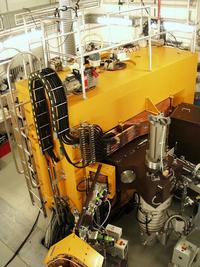
Targeted Alpha Therapy Group
Short description
The Targeted Alpha Therapy Group is a multidisciplinary research group at the Sahlgrenska Academy, University of Gothenburg and the Sahlgrenska University Hospital, Sweden
The main goal of the research group is to develop strategies for the treatment of disseminated cancer using alpha-particle emitters as the leading actor. The research areas covered by the Targeted Alpha Therapy Group include studies of the chemistry related to labeling of radionuclides to different ligands, studies of pharmacokinetics, different aspects of radiation physics such as dosimetry, alpha camera imaging and finally clinical studies in which the developed treatment strategies are evaluated.
Co-workers & Co-authors
Mia Johansson
Pernilla Dahm-Kähler
Karin Welén
Håkan Andersson
Holger Jensen, Chief Physicist, PhD, PET and Cyklotron Unit, Copenhagen University Hospital
Positions available
If you are interested in working in the multidisciplinary environment of the TAT group please contact the relevant person within your specific scientific area for information on any possibilities for Post Doc or PhD Student positions.
Also keep an eye out on the University of Gothenburg's complete list of available positions where all types of currently available positions are announced.
Students interested in performing MSc Thesis or similar are always welcome to contact us with own ideas or to get suggestions on thesis subjects to be performed within the group's different focus areas.
- Stig Palm - Physics
- Sture Lindegren - Chemistry
- Per Albertsson - Clinic / Oncology
- Tom Bäck - Imaging
The targeted alpha therapy group perform research in close collaboration with several international research groups and institutes within all different research areas related to TAT. Most important the targeted alpha therapy group has continuous access to astatine-211 through a long-lasting scientific collaboration with the PET and Cyclotron Unit at Copenhagen University Hospital.
Copenhagen University Hospital
The PET & Cyclotron Unit at Copenhagen University Hospital is organized under the Department of Clinical Physiology and Nuclear Medicine and supplies the TAT-group with 211At under the direction of Chief Physicist, Holger Jensen.
The Cyclotron Unit is focused on producing PET isotopes such as 18F, 13N, 11C, and 15O for the use at the 6 PET and PET/CT scanners in the department. But it also supplies FDG on a daily basis to different customers in the Copenhagen area. Besides this they have a large production of Rubidum/Krypton-generators and finally they produce several unique isotopes like 211At and 111mCd. The latter productions can only be done with the Scanditronix MC32 cyclotron due to the high energy and the possibility of producing alpha-particle-beams. (Fig 1.)
The collaboration since 2000 with the Cyclotron Unit at Rigshospitalet consists of a continuous supply of irradiated 209Bi targets. The targets are irradiated by accelerated alpha particles in the cyclotron, and produces 211At via the nuclear reaction 209Bi(a,2n)211At. The targets are then transported to Gothenburg where the 211At is extracted by dry distillation and later used in our preclinical and clinical studies.
Crump Institute for Molecular Imaging
The Crump Institute at the UCLA is a multidisciplinary collaborative of scientists, students, and technologists in the fields of physics, biology, chemistry, and computational sciences.
The Biomolecular Targeting Research Laboratory at the UCLA focus on understanding and using molecular recognition (protein-protein, nucleic acid-nucleic acid, and protein-nucleic acid) to distinguish tumor cells from normal cells and to develop practical applications in oncology - diagnostic or therapeutic.
The collaboration with the Crump Institute and the Biomolecular Targeting Research Laboratory at the UCLA consists principally of a joint effort to evaluate different antibodies relevant for use in radioimmunotherapeutic approaches to prostate cancer.
Institute for Transuranium Elements
The Institute for Transuranium Elements (ITU) is a European Commission´s Joint Research Centre (JRC). (Fig 2.)
The Institute of Transuranium Elements prime subjectives are to serve as a reference centre for basic actinide research, to contribute to an effective safety and safeguards system for the nuclear fuel cycle, and to study technological and medical applications of radionuclides/actinides.
The facilities of the Alpha-immunotherapy action at ITU include laboratories for radionuclide production, radiobiological testing and organic synthesis.
Since February 2009 there exists a signed collaboration agreement between The European Atomic Energy Community (under which JRC and ITU are organized) and the University of Gothenburg (under which the Departments of Oncology and Radiation Physics are organized). The co-ordinators for this collaboration are Dr. Frank Bruchertseifer for the JRC and Dr. Sture Lindegren for the University of Gothenburg. The collaboration to date consists of ITU supplying 213Bi generators to be used for evaluating the alpha-particle emitter 213Bi in different pre-clinical studies.
Tokyo University
The targeted alpha therapy group is collaborating with scientists under the lead of Dr Akira Sugiyama at the isotope science center at Tokyo University, around, among other things, utilizing astatine-211 in a novel PRIT system developed in Japan.
Vrije Universiteit Brussel
The Vrije Universiteit Brussel is a Flemish university in Belgium where the TAT group collaborates with the Nick DeVoogdt and Tony Lahoutte research group at the In vivo Cellular and Molecular Imaging Lab (Fig 3.)
The collaboration is on the therapy of disseminated cancer using astatine labelled nanobodies. It includes developing chemical methods for astatination and the subsequent preclinical evaluation on tumor bearing mice and ultimately clinical evaluation. Nanobodies with different tumor specificity will be included in the study.
Nanobodies are genetically modified tumor specific antibody structures with origin from camel. It is the smallest antigen fragment available, 15 KD, about ten times smaller than an IgG antibody. The biodistribution of the antigen binding structure is determined by size and compared to normal sized antibodies targeting and clearance of the nanobody is much faster. In this way nanobodies gives new opportunities in targeted imaging and therapy of cancer.



-
ALF - the agreement between the Swedish government and the county councils, the ALF-agreement
- Assar Gabrielsson Foundation
- European Commission
- King Gustav V Jubilee Clinic Research Foundation
- Lundberg's Research Foundation
- NIH - National institutes of Health
- Sahlgrenska University Hospitals Research Foundations
- Swedish Cancer Society
- SSM - Swedish Radiation SAfety Authority
- Swedish Research Council
For a more extensive list of publications please visit this page
Popular Science Articles
Swedish Cancer Foundation
An article on the TAT groups work with targeted alpha therapy of ovarian cancer, brought about the fellowship awarded to Emma Aneheim during 2019 by the same foundation. In Swedish "Konstgjort grundämne ska stråla sönder cancer i äggstockarna"
Science Spotlight - Fred Hutch News
The Fred Hutchinson Cancer Research Center published a popular science news article on their web-page "Fine-tuning radioimmunotherapy with an alpha-emitting radionuclide" in April 15, 2013, concerning a collaborative work with Tom Bäck.
Research Media
Innovative immunotherapy. Lars Jacobsson and Ragnar Hultborn. International Innovation, May 2012, (Research Media, UK, pp 114-116).
Onkologi i Sverige
Konform strålterapi på cellnivå med alfaradioligander. The article (in Swedish) is found via the link below. The article was published in the 5th issue at pages 66-71, 2011.
Dagens Medicin
A summary of the article was published on the 7th of June, 2007.
PhD Theses
Anna Gustafsson-Lutz, Chemist.
Development of targeted alpha therapy with Bi-213 and At-211 for the treatment of disseminated cancer - Synthesis and evaluation of pretargeting components and radioimmunoconjugates. Institute of Clinical Sciences. Sahlgrenska Academy, University of Gothenburg. 2016.
Elin Cederkrantz, Physicist.
Pharmacokinetics and dosimetry in intraperitoneal radioimmunotherapy with At-211. Institute of Clinical Sciences, Sahlgrenska Academy, University of Gothenburg. 2014.
Karin Magnander, Physicist.
Formation and Repair of Complex DNA Damage Induced by Ionizing Radiation Institute of Clinical Sciences. Sahlgrenska Academy. University of Gothenburg. 2013.
Sofia Frost, Chemist.
Pretargeting agents and 211At-labeled effector molecules. Synthesis and preclinical evaluation for pretargeted alpha-radioimmunotherapy. Institute of Clinical Sciences. Sahlgrenska Academy. University of Gothenburg. 2012. Read the thesis here.
Kristina Claesson, Physicist.
Radiobiological effects of alpha-particles from Astatine-211. From DNA damage to cell death. Institute of Clinical Sciences, Sahlgrenska Academy, University of Gothenburg. 2011.
MSc Theses
19. Johan Almblad
Pretargeted radioimmunotherapy using the inverse diels alder addition between tetrazine and trans-cyclooctene Supervisor: Sture Lindegren, Emma Aneheim, 2017.
18. John Apelman
Production of an Avidin Conjugated Antibody Pretargeting Agent Supervisor: Sture Lindegren, Emma Aneheim, 2015.
17. Tierra Duffield
Synthesis and Quality Control of Radiohalogenated PSMA Inhibitors for Targeted Therapy of Prostate Cancer Supervisor: Sture Lindegren, Emma Aneheim, 2015.
16. David Wadsten
Fc-gammaR in Alpha-radioimmunotherapy: Work up of a head to head in vivo comparison of F(ab)2 fragments with intact IgG MX35 Supervisor: Per Albertsson, 2013.
15. Besart Rexhaj
Initial development of voxel dose kernel dosimetry in MATLAB for alpha particles using Alpha Camera imaging of tissue samples Supervisors: Tom Bäck and Stig Palm, 2013.
Articles, Books and Chapters
2020
84. Lindegren S, Albertsson P, Bäck T, Jensen H, Palm S, Aneheim E.Realizing Clinical Trials With Astatine-211: The Chemistry Infrastructure. Cancer Biotherapy and Radiopharmaceuticals 2020;35(2)
2019
83. Aneheim E, Palm S, Jensen H, Ekberg C, Albertsson P, Lindegren S. Towards elucidating the radiochemistry of astatine – Behavior in chloroform.
82. Denk C, Wilkovitsch M, Aneheim E, Herth M, Jensen H, Lindegren S, Mikula H. Multifunctional clickable reagents for rapid bioorthogonal astatination and radio‐crosslinking. ChemPlusChem 2019;84: 775–778
81. Dekempeneer Y, Bäck T, Aneheim E, Jensen H, Puttemans J, Xavier C, Keyaerts M, Palm S, Albertsson P, Lahoutte T, Caveliers V, Lindegren S, D'Huyvetter M, Labeling of anti-HER2 nanobodies with astatine-211: Optimization and the effect of different coupling reagents on their in vivo behaviour.
80. Hallqvist A, Bergmark K, Bäck T, Andersson H, Dahm-Kähler P, Johansson M, Lindegren S, Jensen H, Jacobsson L, Hultborn R, Palm S, Albertsson P. Intraperitoneal alpha-emitting radio immunotherapy with Astatine-211 in relapsed ovarian cancer; long-term follow-up with individual absorbed dose estimations. J Nucl Med, 2019;60(8):1073-1079





